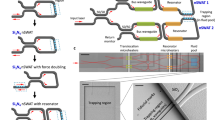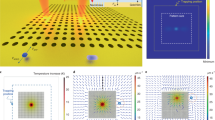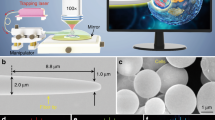Abstract
Optical trapping is a powerful manipulation and measurement technique widely used in the biological and materials sciences1,2,3,4,5,6,7,8. Miniaturizing optical trap instruments onto optofluidic platforms holds promise for high-throughput lab-on-a-chip applications9,10,11,12,13,14,15,16. However, a persistent challenge with existing optofluidic devices has been achieving controlled and precise manipulation of trapped particles. Here, we report a new class of on-chip optical trapping devices. Using photonic interference functionalities, an array of stable, three-dimensional on-chip optical traps is formed at the antinodes of a standing-wave evanescent field on a nanophotonic waveguide. By employing the thermo-optic effect via integrated electric microheaters, the traps can be repositioned at high speed (∼30 kHz) with nanometre precision. We demonstrate sorting and manipulation of individual DNA molecules. In conjunction with laminar flows and fluorescence, we also show precise control of the chemical environment of a sample with simultaneous monitoring. Such a controllable trapping device has the potential to achieve high-throughput precision measurements on chip.
This is a preview of subscription content, access via your institution
Access options
Subscribe to this journal
Receive 12 print issues and online access
$259.00 per year
only $21.58 per issue
Buy this article
- Purchase on Springer Link
- Instant access to full article PDF
Prices may be subject to local taxes which are calculated during checkout




Similar content being viewed by others
References
Chu, S. The manipulation of neutral particles. Rev. Mod. Phys. 70, 685–706 (1998).
Forth, S., Sheinin, M., Inman, J. & Wang, M. Torque measurement at the single-molecule level. Annu. Rev. Biophys. 42, 583–604 (2013).
Moffitt, J. R., Chemla, Y. R., Smith, S. B. & Bustamante, C. Recent advances in optical tweezers. Annu. Rev. Biochem. 77, 205–228 (2008).
Hilario, J. & Kowalczykowski, S. C. Visualizing protein–DNA interactions at the single-molecule level. Curr. Opin. Chem. Biol. 14, 15–22 (2010).
Dholakia, K. & Cizmar, T. Shaping the future of manipulation. Nature Photon. 5, 335–342 (2011).
Padgett, M. & Bowman, R. Tweezers with a twist. Nature Photon. 5, 343–348 (2011).
Jannasch, A., Demirors, A. F., van Oostrum, P. D. J., van Blaaderen, A. & Schaffer, E. Nanonewton optical force trap employing anti-reflection coated, high-refractive-index titania microspheres. Nature Photon. 6, 469–473 (2012).
Grier, D. G. A revolution in optical manipulation. Nature 424, 810–816 (2003).
Fainman, Y., Psaltis, D. & Yang, C. Optofluidics: Fundamentals, Devices, and Applications Ch. 17, (McGraw-Hill, 2010).
Erickson, D., Serey, X., Chen, Y. F. & Mandal, S. Nanomanipulation using near field photonics. Lab on a Chip 11, 995–1009 (2011).
Erickson, D., Rockwood, T., Emery, T., Scherer, A. & Psaltis, D. Nanofluidic tuning of photonic crystal circuits. Opt. Lett. 31, 59–61 (2006).
Diehl, L. et al. Microfluidic tuning of distributed feedback quantum cascade lasers. Opt. Express 14, 11660–11667 (2006).
Psaltis, D., Quake, S. R. & Yang, C. Developing optofluidic technology through the fusion of microfluidics and optics. Nature 442, 381–386 (2006).
Juan, M. L., Righini, M. & Quidant, R. Plasmon nano-optical tweezers. Nature Photon. 5, 349–356 (2011).
Schmidt, H. & Hawkins, A. R. The photonic integration of non-solid media using optofluidics. Nature Photon. 5, 598–604 (2011).
Fan, X. D. & White, I. M. Optofluidic microsystems for chemical and biological analysis. Nature Photon. 5, 591–597 (2011).
Molloy, J. E., Burns, J. E., Kendrick-Jones, J., Tregear, R. T. & White, D. C. Movement and force produced by a single myosin head. Nature 378, 209–112 (1995).
Farre, A., van der Horst, A., Blab, G. A., Downing, B. P. B. & Forde, N. R. Stretching single DNA molecules to demonstrate high-force capabilities of holographic optical tweezers. J. Biophoton. 3, 224–233 (2010).
Yang, A. H. J. et al. Optical manipulation of nanoparticles and biomolecules in sub-wavelength slot waveguides. Nature 457, 71–75 (2009).
Lin, S. Y. & Crozier, K. B. Planar silicon microrings as wavelength-multiplexed optical traps for storing and sensing particles. Lab on a Chip 11, 4047–4051 (2011).
Lin, S. Y. & Crozier, K. B. An integrated microparticle sorting system based on near-field optical forces and a structural perturbation. Opt. Express 20, 3367–3374 (2012).
Schmidt, B. S., Yang, A. H. J., Erickson, D. & Lipson, M. Optofluidic trapping and transport on solid core waveguides within a microfluidic device. Opt. Express 15, 14322–14334 (2007).
Mandal, S., Serey, X. & Erickson, D. Nanomanipulation using silicon photonic crystal resonators. Nano Lett. 10, 99–104 (2010).
Renaut, C. et al. On chip shapeable optical tweezers. Sci. Rep. 3, 2290–2293 (2013).
Jaquay, E., Martinez, L. J., Mejia, C. A. & Povinelli, M. L. Light-assisted, templated self-assembly using a photonic-crystal slab. Nano Lett. 13, 2290–2294 (2013).
Lei, T. & Poon, A. W. Silicon-on-insulator multimode-interference waveguide-based arrayed optical tweezers (SMART) for two-dimensional microparticle trapping and manipulation. Opt. Express 21, 1520–1530 (2013).
Soltani, M., Inman, J. T., Lipson, M. & Wang, M. D. Electro-optofluidics: achieving dynamic control on-chip. Opt. Express 20, 22314–22326 (2012).
Atabaki, A. H., Hosseini, E. S., Eftekhar, A. A., Yegnanarayanan, S. & Adibi, A. Optimization of metallic microheaters for high-speed reconfigurable silicon photonics. Opt. Express 18, 18312–18323 (2010).
Moffitt, J. R., Chemla, Y. R., Izhaky, D. & Bustamante, C. Differential detection of dual traps improves the spatial resolution of optical tweezers. Proc. Natl Acad. Sci. USA 103, 9006–9011 (2006).
Abbondanzieri, E. A., Greenleaf, W. J., Shaevitz, J. W., Landick, R. & Block, S. M. Direct observation of base-pair stepping by RNA polymerase. Nature 438, 460–465 (2005).
Sun, B. et al. ATP-induced helicase slippage reveals highly coordinated subunits. Nature 478, 132–135 (2011).
Forget, A. L., Dombrowski, C. C., Amitani, I. & Kowalczykowski, S. C. Exploring protein–DNA interactions in 3D using in situ construction, manipulation and visualization of individual DNA dumbbells with optical traps, microfluidics and fluorescence microscopy. Nature Protoc. 8, 525–538 (2013).
Gelles, J., Schnapp, B. J. & Sheetz, M. P. Tracking kinesin-driven movements with nanometre-scale precision. Nature 331, 450–453 (1988).
Fuller, D. N. et al. A general method for manipulating DNA sequences from any organism with optical tweezers. Nucleic Acids Res. 34, e15–e24 (2006).
Laib, S., Robertson, R. M. & Smith, D. E. Preparation and characterization of a set of linear DNA molecules for polymer physics and rheology studies. Macromolecules 39, 4115–4119 (2006).
Acknowledgements
The authors thank members of the Wang Lab and the Lipson Lab for critical comments on this work. We especially thank J.L. Killian, L.D. Brennan, T. Roland, T.M. Konyakhina, and G.W. Feigenson for technical assistance. The authors acknowledge postdoctoral support to R.A.F. from the American Cancer Society (125126-PF-13-205-01-DMC), graduate traineeship support to S.N.S. from Cornell's Molecular Biophysics Training Grant funded by the National Institutes of Health (NIH, T32GM008267) and a National Science Foundation (NSF) Graduate Research Fellowship (grant no. DGE-1144153), and support to M.D.W. by the NIH (GM059849) and the NSF (MCB-0820293). This work was performed in part at the Cornell NanoScale Facility, a member of the National Nanotechnology Infrastructure Network, which is supported by the NSF (grant ECCS-0335765).
Author information
Authors and Affiliations
Contributions
M.D.W. conceived the original concept for nSWAT and supervised the project. M.D.W. and M.S. collaborated on the experimental design and implementation. M.S. tested and optimized early prototypes of the nSWAT device. M.S. designed and simulated detailed features necessary to realize the current nSWAT implementation. M.S. and J.L. fabricated the devices with help from J.T.I., S.N.S. and M.L. J.L., R.A.F., M.S., J.T.I., S.N.S. and M.D.W. designed the measurement experiments. J.L., R.A.F., M.S. and S.N.S. performed the experiments with help from J.T.I. R.A.F., M.S. and J.L. analysed the data with help from S.N.S. J.T.I., J.L., R.A.F, M.S., S.N.S. and R.M.F. upgraded an existing measurement setup. M.D.W. and M.L. contributed materials/analysis tools. All authors contributed in drafting of the manuscript.
Corresponding author
Ethics declarations
Competing interests
The authors declare no competing financial interests.
Supplementary information
Supplementary information
Supplementary Information (PDF 711 kb)
Supplementary Movie 1
Supplementary Movie 1 (MOV 1776 kb)
Supplementary Movie 2
Supplementary Movie 2 (MOV 1816 kb)
Supplementary Movie 3
Supplementary Movie 3 (MOV 3046 kb)
Rights and permissions
About this article
Cite this article
Soltani, M., Lin, J., Forties, R. et al. Nanophotonic trapping for precise manipulation of biomolecular arrays. Nature Nanotech 9, 448–452 (2014). https://doi.org/10.1038/nnano.2014.79
Received:
Accepted:
Published:
Issue Date:
DOI: https://doi.org/10.1038/nnano.2014.79
This article is cited by
-
Light Controlled Nanobiohybrids for Modulating Chiral Alcohol Synthesis
Applied Biochemistry and Biotechnology (2023)
-
Resonator nanophotonic standing-wave array trap for single-molecule manipulation and measurement
Nature Communications (2022)
-
Low cost and massively parallel force spectroscopy with fluid loading on a chip
Nature Communications (2022)
-
Optical tweezers in single-molecule biophysics
Nature Reviews Methods Primers (2021)
-
The toxicity of SiO2 NPs on cell proliferation and cellular uptake of human lung fibroblastic cell line during the variation of calcination temperature and its modeling by artificial neural network
Journal of Environmental Health Science and Engineering (2021)



